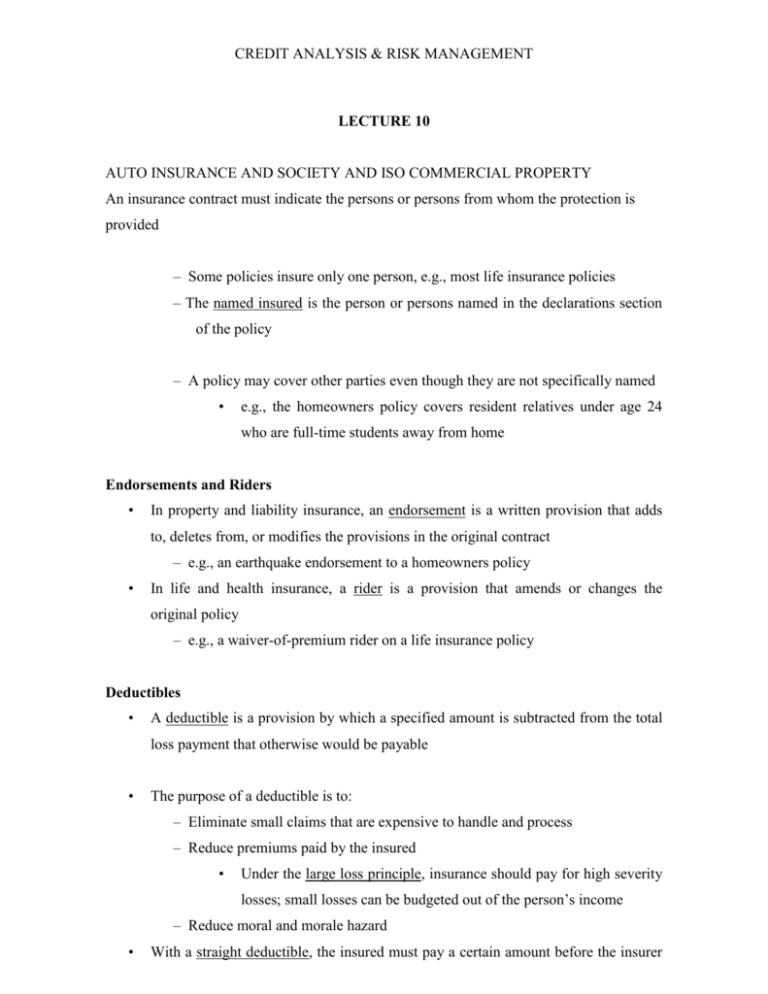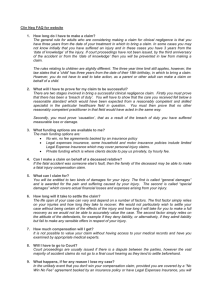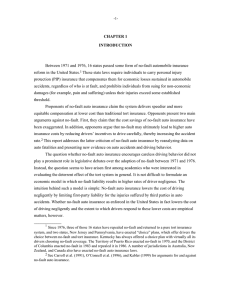CREDIT ANALYSIS & RISK MANAGEMENT
advertisement

CREDIT ANALYSIS & RISK MANAGEMENT LECTURE 10 AUTO INSURANCE AND SOCIETY AND ISO COMMERCIAL PROPERTY An insurance contract must indicate the persons or persons from whom the protection is provided – Some policies insure only one person, e.g., most life insurance policies – The named insured is the person or persons named in the declarations section of the policy – A policy may cover other parties even though they are not specifically named • e.g., the homeowners policy covers resident relatives under age 24 who are full-time students away from home Endorsements and Riders • In property and liability insurance, an endorsement is a written provision that adds to, deletes from, or modifies the provisions in the original contract – e.g., an earthquake endorsement to a homeowners policy • In life and health insurance, a rider is a provision that amends or changes the original policy – e.g., a waiver-of-premium rider on a life insurance policy Deductibles • A deductible is a provision by which a specified amount is subtracted from the total loss payment that otherwise would be payable • The purpose of a deductible is to: – Eliminate small claims that are expensive to handle and process – Reduce premiums paid by the insured • Under the large loss principle, insurance should pay for high severity losses; small losses can be budgeted out of the person’s income – Reduce moral and morale hazard • With a straight deductible, the insured must pay a certain amount before the insurer CREDIT ANALYSIS & RISK MANAGEMENT makes a loss payment – e.g., an auto insurance deductible • An aggregate deductible means that all losses that occur during a specified time period are accumulated to satisfy the deductible amount Deductibles in Health Insurance • A calendar-year deductible is a type of aggregate deductible that is found in basic medical expense and major medical insurance contracts • A corridor deductible is a deductible that can be used to integrate a basic medical expense plan with a supplemental major medical expense plan • An elimination (waiting) period is a stated period of time at the beginning of a loss during which no insurance benefits are paid Coinsurance • A coinsurance clause in a property insurance contract encourages the insured to insure the property to a stated percentage of its insurable value – If the coinsurance requirement is not met at the time of the loss, the insured must share in the loss as a coinsurer Amount of insurance carried x Loss =Amount of recovery Amount of insurance required • The purpose of coinsurance is to achieve equity in rating – A property owner wishing to insure for a total loss would pay an inequitable premium if other property owners only insure for partial losses CREDIT ANALYSIS & RISK MANAGEMENT – If the coinsurance requirement is met, the insured receives a rate discount, and the policy-owner who is underinsured is penalized through application of the coinsurance formula Coinsurance in Health Insurance • Health insurance policies frequently contain a percentage participation clause – The clause requires the insured to pay a certain percentage of covered medical expenses in excess of the deductible – The purpose is to reduce premiums and prevent over-utilization of policy benefits Other-insurance Provisions • The purpose of other-insurance provisions is to prevent profiting from insurance and violation of the principle of indemnity – Under a pro rata liability provision, each insurer’s share of the loss is based on the proportion that its insurance bears to the total amount of insurance on the property – Under contribution by equal shares, each insurer shares equally in the loss until the share paid by each insurer equals the lowest limit of liability under any policy, or until the full amount of the loss is paid – Under a primary and excess insurance provision, the primary insurer pays first, and the excess insurer pays only after the policy limits under the primary policy are exhausted – The coordination of benefits provision in group health insurance is designed to prevent over-insurance and the duplication of benefits if one person is covered under more than one group health insurance plan • e.g., two employed spouses are insured as dependents under each other’s group health insurance plan CREDIT ANALYSIS & RISK MANAGEMENT Social Insurance • Social insurance programs are necessary for several reasons: – To help solve complex social problems – To provide coverage for perils that are difficult to insure privately – To provide a base of economic security to the population Basic Characteristics of Social Insurance • Social insurance programs have certain characteristics that distinguish them from other government insurance programs: – Most programs are compulsory • This makes it easier to provide a floor of income to the population • It also reduces adverse selection – Programs are designed to provide a floor of income – Programs pay benefits based largely on social adequacy rather than individual equity • The benefits are heavily weighted in favor of certain groups, such as low-income persons, large families, and retirees – Benefits are loosely related to the workers’ earnings – Programs, benefits, and benefit formulas are prescribed by law – A formal means test is not required • A means test involves disclosing income and assets – Full funding of benefits is unnecessary • For example, it is not necessary to fully fund Social Security because workers will always enter the program and support it – Programs are designed to be financially self-supporting • Programs should be almost completely financed from the earmarked contributions of covered employees CREDIT ANALYSIS & RISK MANAGEMENT The Liability Risk Basis of Legal Liability • A legal wrong is a violation of a person’s legal rights, or a failure to perform a legal duty owed to a certain person or to society as a whole • Legal wrongs include: – Crime – Breach of contract – Tort • A tort is a legal wrong for which the court allows a remedy in the form of money damages • The person who is injured (plaintiff) by the action of another (tortfeasor) can sue for damages • Torts fall into three categories: – Intentional, e.g., fraud, assault – Strict liability: liability is imposed regardless of negligence or fault – Negligence Law of Negligence • Negligence is the failure to exercise the standard of care required by law to protect others from an unreasonable risk of harm – The standard of care is not the same for each wrongful act. It is based on the care required of a reasonably prudent person • Elements Negligence – Existence of a legal duty to use reasonable care – Failure to perform that duty – Damage or injury to the claimant – Proximate cause relationship between the negligent act and the infliction of CREDIT ANALYSIS & RISK MANAGEMENT damages • • A proximate cause relationship requires an unbroken chain of events The law allows for the following types of damages: – Compensatory damages compensate the victim for losses actually incurred. They include: • Special damages, e.g., medical expenses • General damages, e.g., pain and suffering – Punitive damages are designed to punish people and organizations so that others are deterred from committing the same wrongful act • The ability to collect damages for negligence depends on state law • Under a contributory negligence law, the injured person cannot collect damages if his or her care falls below the standard of care required for his or her protection – Under strict application of common law, the injured cannot collect damages if his or her conduct contributed in any way to the injury • Under a comparative negligence law, the financial burden of the injury is shared by both parties according to their respective degrees of fault – Under the pure rule, you can collect damages even if you are negligent, but your reward is reduced in proportion to your fault – Under the 49 percent rule, you can collect damages only if your negligence is less than the negligence of the other party – Under the 50 percent rule, you can recover reduced damages only if your negligence is not greater than the negligence of the other party • Some legal defenses can defeat a claim for damages: – The last clear chance rule states that a plaintiff who is endangered by his or her own negligence can still recover damages from the defendant if the defendant has a last clear chance to avoid the accident but fails to do so. – Under the assumption of risk doctrine, a person who understands and recognizes the danger inherent in a particular activity cannot recover damages in the event of an injury CREDIT ANALYSIS & RISK MANAGEMENT AUTO INSURANCE AND SOCIETY Approaches for Compensating Auto Accident Victims • Many accident victims are unable to recover damages – The negligent driver may be uninsured or underinsured • States use a number of approaches to protect accident victims from irresponsible or reckless drivers • A financial responsibility law requires motorists to furnish proof of financial responsibility up to certain minimum dollar limits – Proof is required: • After an accident involving bodily injury or property damage over a certain amount • • Upon failure to pay a final judgment resulting from an auto accident • Following a conviction for certain offenses, such as DUI Evidence of financial responsibility can be provided in several ways: – Producing evidence of an auto liability insurance policy with at least certain minimum limits – Posting a bond – Depositing the amount required by law – Showing that the person is a qualified self-insurer • Financial responsibility laws provide only limited protection against irresponsible motorists – There is no guarantee that all accident victim will be paid • The victim may not be paid if injured by an uninsured driver, hit-and-run driver, or driver of a stolen car – State laws require only minimum liability limits, which are relatively low CREDIT ANALYSIS & RISK MANAGEMENT • A compulsory insurance law requires motorists to carry at least a minimum amount of liability insurance before the vehicle can be licensed or registered – Some argue that the law provides greater protection against uninsured drivers because motorists must provide evidence of financial responsibility before an accident occurs – Critics cite: mandatory insurance does not reduce the number of uninsured drivers • There is no correlation between compulsory insurance laws and the number of uninsured vehicles on the highway – Computer reporting systems to track uninsured motorists have not been effective • For example Five states in USA have established unsatisfied judgment funds for compensating auto accident victims who have exhausted all other means of recovery – The accident must obtain a judgment against the negligent motorist and show that the judgment cannot be collected – The amount paid by the fund is limited by state law and may be reduced by collateral sources – The negligent driver must repay the fund – States use different methods for financing the benefits, e.g., through insurer assessments • Many states require uninsured motorists coverage – The injured person’s insurer agrees to compensate for bodily injury caused by an uninsured motorist, a hit-and-run driver, or a negligent driver whose insurer is insolvent • Some states include property damage losses – One advantage is that claim settlement is faster than a tort liability lawsuit – The injured person must establish that the uninsured motorist is legally liable for the accident – The minimum limits are low, so an accident victim may not be fully compensated CREDIT ANALYSIS & RISK MANAGEMENT • Low-cost auto insurance provides minimum amounts of liability insurance at reduced rates to motorists who cannot afford regular insurance – Goal is to reduce the number of uninsured drivers – A pilot program in California does not appear to be effective • • Many drivers still find auto insurance to be too expensive Several states have enacted “no pay, no play” laws which prohibit uninsured motorists from suing negligent drivers for non-economic damages No-fault Auto Insurance • No-fault auto insurance is another method for compensating injured accident victims • About half of the states have no-fault auto insurance laws in effect – After an auto accident involving bodily injury, each party collects from his or her own insurer regardless of fault – Enacted because of dissatisfaction and defects in the traditional tort liability system • No-fault plans vary among the states: – Under a pure no-fault plan, accident victims cannot sue at all, regardless of the amount of the claim • No states have enacted a pure no-fault plan – Under a modified no-fault plan, victims have a limited right to sue: • In some states, an injured driver may sue if the bodily injury claim exceeds a certain monetary threshold • In some states, an injured driver may sue if the bodily injury claim exceeds a verbal threshold, e.g., if the injury involves death, dismemberment, disfigurement, or permanent loss of a bodily member or function – An add-on plan pays benefits to an accident victim without regard to fault, and the injured person has the right to sue the negligent driver who caused the accident CREDIT ANALYSIS & RISK MANAGEMENT • Not a true no-fault plan – Under a choice no-fault plan, motorists can elect to be covered under the state’s no-fault law and pay lower premiums • Or, they can retain the right to sue under the tort liability system and pay higher premiums • No-fault benefits are provided by adding an endorsement to an auto insurance policy – Benefits are restricted to the injured person’s economic loss, which includes: • Medical expenses • Loss of earnings • Essential services expenses, e.g., housework • Funeral expenses • Survivors’ loss benefits, i.e., periodic payments to a surviving spouse and dependent children – In some states, insurers must also offer optional no-fault benefits above the prescribed minimums • The right to sue varies across states with no-fault or add-on plans – All states permit a lawsuit in the event of a serious injury • No-fault laws cover only bodily injury and not property damage – Except in Michigan – Motorists are allowed to sue the negligent driver for property damage • • Cases are usually small and resolved quickly Arguments in support of no-fault laws include: – Difficulty in determining fault – Inequity in claim payments • Serious claims may be underpaid – High transactions costs and attorney fees CREDIT ANALYSIS & RISK MANAGEMENT • Less than half of all tort dollars reach injured victims – Fraudulent and inflated claims • When pain and suffering awards are based on a multiple of medical expenses and wage loss, claimants have a powerful incentive to inflate their claims – Delay in payments • Many claims are not paid promptly because of the time consumed by investigation, negotiation, and waiting for a court date • Arguments against no-fault laws include: – Defects of present system are exaggerated – Savings from no-fault are exaggerated – Court delays are confined to a few large cities – Safe drivers may be penalized by no-fault • The rating system may inequitably allocate accident costs to the drivers who are not at fault, thus raising their premiums – No-fault provides no payment for pain and suffering – The present tort liability system should be improved, not junked • Some states have repealed their no-fault laws because relatively low monetary thresholds have increased the number of lawsuits • A study by the Institute for Civil Justice found that no-fault plans: – reduce attorney fees and claim processing costs – match the compensation received for an injury more closely with the economic loss sustained – generally pay benefits more quickly • The study concluded that savings from a no-fault plan depend on the provisions in the plan Auto Insurance for High Risk Drivers • High risk drivers who have difficulty obtaining auto insurance in the voluntary CREDIT ANALYSIS & RISK MANAGEMENT market can obtain insurance in the shared (residual) market – These are typically younger drivers, drivers with poor driving records, and drivers with convictions for drunk driving • Most states have an auto insurance plan (assigned risk plan) that makes auto insurance available to motorists who are unable to obtain insurance in the voluntary market – All auto insurers in the state are assigned a proportionate share of high-risk drivers, depending on their total volume of auto insurance premiums written in the state – Premiums charged are substantially higher than those charged in the voluntary markets • A few states have established a joint underwriting association (JUA), in which auto insurers in the state participate in providing coverage to high-risk drivers through a common pool – Each insurer pays its pro rata share of pool losses and expenses – The JUA designs the policies and sets the rates – Underwriting losses are proportionately shared by the companies based on premiums written in the state – A limited number of insurers are designated as servicing insurers, but all insurers participate in the pool • A few states have established a reinsurance facility (or pool) for placing high-risk drivers – Insurers must accept all applicants • If the applicant is considered a high-risk driver, the insurer has the option of placing the driver in the reinsurance pool – Underwriting losses are shared by all auto insurers in the state • The Maryland Automobile Insurance Fund is a state fund that provides insurance to high-risk drivers who have been canceled or refused insurance by private insurers • Specialty insurers are insurers that specialize in insuring motorists with poor driving records CREDIT ANALYSIS & RISK MANAGEMENT Cost of Auto Insurance • Auto insurance rates have increased in recent years due to: – Rising medical and higher motor vehicle repair costs – Soaring jury awards in liability cases – Insurance fraud and abuse • Insurers use a variety of factors to establish auto insurance premiums, including: – Territory – Age, gender, and marital status – Use of the auto – Driver education – Number and types of cars • A multicar discount is available if the insured owns two or more cars – Good student discount – Individual driving record • Many insurers offer a safe driver plan for drivers with clean records – An insurance score, based on an applicant’s credit record Basics of Auto Insurance






